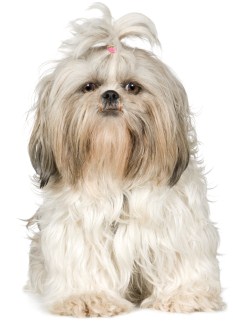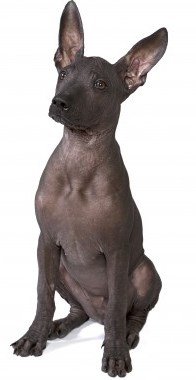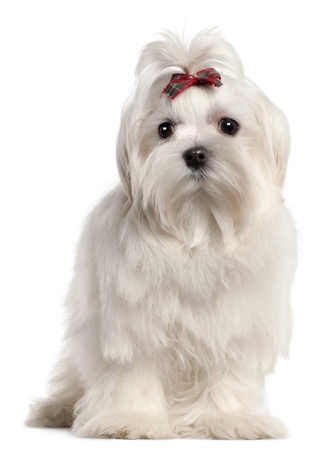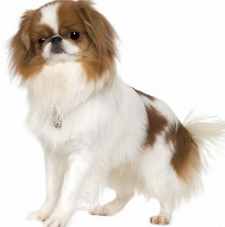Chinese Crested Powderpuff
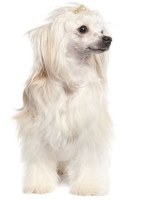
The Chinese Crested Powderpuff maybe one of those best-kept secrets of the dog world—gentle, happy, loving and totally devoted to his owner.
Many people label their small breed dog a Velcro dog because they tend to follow you everywhere, and no dog deserves this description more than the Chinese Crested.
Many people know the breed through their notoriety in the annual Ugliest Dog Contest. However, that does not begin to do the breed justice.
Sometimes affectionately called the Dr. Seuss dog because the hairless variety can resemble some of the unusual characters imagined by the famous children’s author and illustrator.
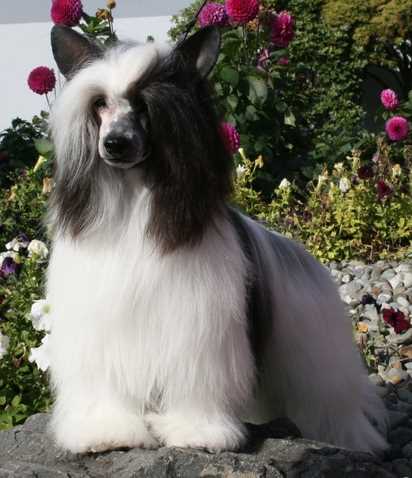
There are two varieties of this breed, the hairless and powderpuff. They are both members of the same breed although they look vastly different.
Genetically there is no difference, and both hairless and powderpuff varieties occur in the same litter.
Slight boned and delicate, these dogs have often been described as cat-like. They “perch” on the back of a sofa, on your lap, or share your pillow at night. If cold, they are just as likely to borrow under the covers with you.
On both varieties, their ears can be up or down. Show dogs must have erect ears and breeders or owners may tape the ears if they do not stand up on their own. Pet owners can decide whether they want the ears up or down.
Both varieties do not do well in the cold. The hairless, in particular, will need coats in the winter, but even the powderpuff will appreciate a warm sweater or coat in severe weather.
They seem to do better in the heat, but either way, they must always be considered inside dogs. Never leave a crested outdoors.
Chinese Crested Powderpuffs are people dogs and do not do well if separated for long periods of time. If left alone, they can suffer from separation anxiety and become barkers or destructive.
Their sensitive nature sometimes makes them difficult to train unless you are patient and very gentle in your methods. Like many small breed dogs, housebreaking usually takes longer, and many will relapse from time to time.
The Chinese Crested powderpuff variety has a silky, thick double coat that consists of a straight silky outer coat and a short wooly undercoat.
Beyond the outward appearance, there is little else to distinguish the two varieties of the Chinese Crested.
Quick Facts about the Chinese Crested Powderpuff
Other Names Used: Chinese Hairless, The Chinese Edible Dog, Chinese Ship Dog, and Chinese Royal Hairless (These names are not used today); Crested, Puffs, Hairless
Affiliation: AKC, CKC, KC, NZKC: Toy Group, UKC Companion Breeds
Size
Height: 11-13 inches (28 -33 cm.)
Weight: 10–13 lb. (4.5–5.9 kg)
Coat Type: Powderpuff variety has a thick double coat
Colors: Colors recognized by the AKC: Apricot, Black, Black, White and Tan, Blue, Chocolate, Cream, Palomino, Pink, and Chocolate, Pink and Slate, White, Black and Tan, Black and White, Brown, Pink, Red, Sable, Silver, White and Black, White and Chocolate
Country of Origin: Africa or China
Activity Level: Moderate
Life Expectancy: 12 to 14 years; some live much longer
Good with Children: Yes
Good with other Pets: Yes
History
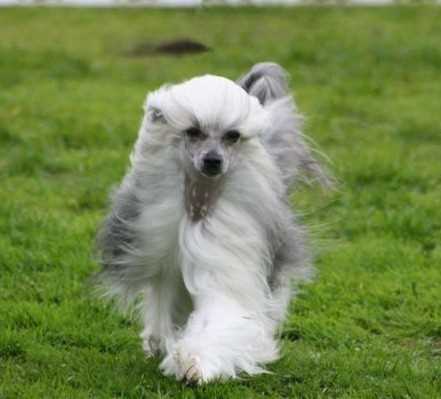
No early written historical records exist concerning the origins of this breed, so theories and speculation have filled in the gaps.
One speculation suggests that the Chinese Crested breed has its ancestry tied to African hairless dogs. These small-sized dogs were said to be traded extensively by merchants and sailors, moving from one port to another, and eventually made their way to China.
The Chinese reportedly cherished small dogs and engaged in a breeding program involving these hairless dogs and other small dog breeds, effectively reducing their size and eventually giving birth to a distinct new breed.
Another theory suggests that the Chinese Crested breed could have originated from Mexico. Some historical records show that in the 1500s, Chinese traders bought these small hairless dogs from Mexican locals and then sold them to other ports around the world.
Regardless of their origins, it is well-documented that by the 1800s, the Chinese Crested appeared in ports across Central America, South America, and various parts of Asia. These dogs were regular passengers on sailing ships, where they played a vital role in catching vermin, including rats that were carriers of the plague.
The Chinese Crested's hairless variety provided additional utility on these ships, serving as a "canine hot water bottle" to sailors who needed warmth due to sickness. Unfortunately, when food stores ran low on voyages, these dogs also reportedly served as a food source for the sailors.
The breed didn't achieve recognition in the West until the late 1800s when it began appearing in dog shows. Initially, these dogs were showcased by prominent ladies of the entertainment industry. The American Kennel Club only accepted them into the Miscellaneous Class in 1955, and full breed recognition didn’t occur until 1991.
When dog shows became fashionable in the late 1800s, an occasional Chinese Crested was among the dogs exhibited.
Throughout the first half of the 20th century, these dogs were being shown by enthusiasts especially ladies prominent in the entertainment industry.
The breed was accepted into the Miscellaneous Class of the American Kennel Club in 1955 but not fully accepted as a breed until 1991.
Though there’s ongoing research and new found interest surrounding the breed’s history, it’s important to remember that most of these theories remain speculations, as the breed’s true origins remain undetermined to date.
Personality of the Chinese Crested Powderpuff
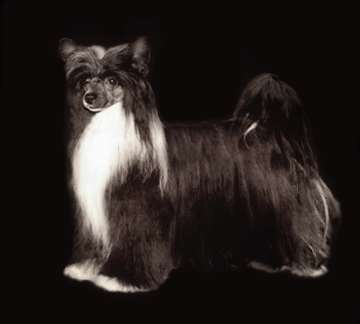
Look at a picture of a Chinese Crested Powderpuff, and you might think he is
smiling at you. Whether they actually smile or just show off their lovely
face, this breed showers his owner in love and devotion. The Chinese Crested Powderpuff has a charming personality marked by affection, passion, and a low level of inherent aggression.
If you are the
proud owner, you will have a loyal companion, but remember they are
rather sensitive, so only a gentle touch will be acceptable by these
dogs.
The Powderpuff is a highly social dog and does not do well if you leave him alone for long
periods of time. They can often be “needy” of your attention but shy
around strangers.
Although
they may be the ultimate cuddle bug, they are active, entertaining, and
playful. These dogs are a little timid around strangers, so puppy
socialization is most important.
They thrive on companionship and cherish being integral members of a family. Known as a 'Velcro' dog, they adore following their owners around.
They display considerable warmth towards children, and their gentle and playful nature makes them excellent companions for kids.
Living harmoniously with other pets is seldom an issue, although initial careful introductions are recommended. The Powderpuff suits those seeking a devoted and sociable pet, but their sensitive nature calls for a loving and considerate approach to ensure they feel safe and valued.
Despite their loving nature to their own family, they can be a bit reserved around strangers. They can sometimes display timidity and caution towards unfamiliar faces, hence the importance of early socialization to help them grow confident in varying social scenarios.
Nonetheless, their adaptable and pleasant character makes the Chinese Crested Powderpuff a delightful family pet.
An occasional walk will do him
fine, but they can get all the exercise they need indoors by playing and
following his owner from room to room.
They do well in agility,
obedience, lure coursing and conformation. They also enjoy a lively
game of fetch now and again.
Their quiet nature and their slight
energy needs make them an ideal companion for a city or apartment
dweller.
But, because they are so flexible, they also do equally well in the country or rural areas as in the city.
Best Environments for the Chinese Crested Powderpuff
The Chinese Crested Powderpuff is a highly adaptable breed, making them suitable for a variety of living situations. Whether in a city apartment or a home in the countryside, these dogs can thrive, so long as they have their beloved human companions nearby.
In city apartments, these dogs do well because of their small size and relatively low exercise demands. They are content with indoor play and short daily walks, making them ideal for urban dwellers who do not have access to a large yard.
Their quiet nature also ensures they are not likely to be a nuisance to neighbors. However, it's important to bear in mind that they are prone to separation anxiety and may not do well left alone for extended periods of time.
In a rural setting, the Powderpuff will enjoy larger spaces to play and explore. However, they should not be left outside unsupervised. While the Powderpuff loves to run and chase, they also have a strong desire for human companionship, which means they'll happily trade outdoor playtime for a cozy snuggle indoors.
Regardless of where they live, maintaining a comfortable temperature environment is important since these breeds do not fare well in extreme cold or heat conditions. The hairless variant, in particular, requires extra care such as doggy sweaters in colder weather and sunscreen in hot, sunny conditions.
In essence, the ideal living situation for a Chinese Crested Powderpuff is determined less by geographical location and more by the care, companionship, and love provided by their owners. They thrive in a living situation that provides them with social interactions, a consistent routine, a balanced diet, and regular health checks to ensure their well-being.
Grooming the Chinese Crested Powderpuff
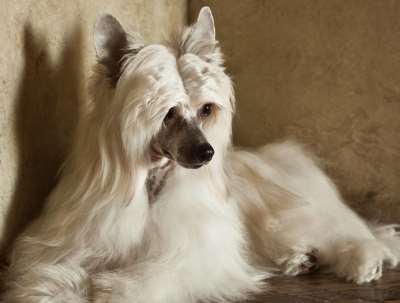
Both varieties require grooming, but the Chinese Crested powderpuff needs more. Their double coat continues to grow to be quite long.
There is little
shedding, so that you will not find hairs around your home, but this
means that the coat can mat easily.
For the hairless variety, regular bathing and skin care are crucial to prevent dirt buildup, skin irritations and acne.
Sunscreen should also be applied to protect their skin from harmful UV rays. The powderpuff variety has a soft, silky, double-layered coat that needs frequent brushing to prevent matting and tangling.
A spray-on conditioner can be used before brushing to protect the hair and decrease static. This breed has comparatively low shedding, but the hair can grow quite long if not maintained by regular trimming.
A ‘Pony’ cut—leaving long hair only on the bottom of the legs, tail, and head—is popular among Powderpuffs not shown in competitions.
Both varieties require regular dental and ear care.
Cleaning their ears to avoid infections and brushing their teeth to prevent dental diseases are an integral part of their grooming routine.
These care and grooming practices will ensure your Chinese Crested stays comfortable, healthy, and happy.
Since shedding is minimal, these dogs are considered hypoallergenic and might be perfect for allergy sufferers.
Nails should be kept short, but the “quick” or blood vessels running through the nails are longer on the Crested than other breeds.
Long
quicks in their toe nails result because they have a different shape of the foot often
called a “hare foot.” Hare foot, as the name implies resembles the foot
of a rabbit—longer and thinner than the average dog
foot.
A weekly bath is often recommended to keep them looking and
smelling fresh.
Health Concerns of the Chinese Crested Powderpuff
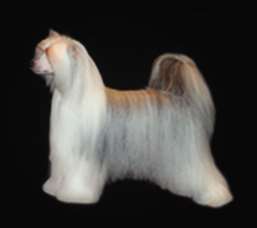
While Chinese Crested Powderpuffs are generally considered healthy, they are susceptible to certain breed-specific health problems.
Besides progressive retinal atrophy (PRA), primary lens luxation, and dry eye syndrome, they can also be prone to dental issues, particularly missing or crowded teeth, which can lead to more severe dental diseases if not properly attended to.
Another unique health concern connected with Chinese Crested dogs is canine multiple system degeneration (CMSD). This is a progressive neurologic disorder that can cause difficulty in coordination and balance, often noticeable when the puppy starts to walk.
For the hairless variety, skin issues can be more prominent due to their increased exposure to environmental elements. This includes allergies, irritations, and sunburn, while acne is common during adolescence.
As for genetic tests, the Orthopedic Foundation for Animals (OFA) offers a variety of testing for Chinese Crested dogs. DNA-based tests for progressive retinal atrophy, primary lens luxation, and breed-specific eye and cardiac exams can be conducted to identify any potential health risks. For breeders, it's recommended to undertake genetic tests to ensure producing healthier and genetically sound litters.
It is always vital for potential owners to seek out reputable breeders who conduct the necessary genetic testing and who are transparent about the health of their breeding animals.
There are genetic tests currently available for one form of PRA and Primary Lens Luxation. The tests will only determine if the sire or dam is a carrier, is clear or is affected. It is not fool foolproof, but responsible breeders will have their crested dogs’ eyes check routinely.
Another eye problem that can occur is called
Keratoconjunctivitis sicca or dry eye syndrome.
They are also prone
to several skeletal problems such as Luxating patella and Legg-Perthes
Disease, two very common conditions in small breed dogs.
What's Good and Bad About this Dog Breed
Pros
- Family friendly dogs, good with children and other pets
- Relatively quiet breed, good for apartment dwellers
- Playful, loving, devoted companions
- Small size, makes them good for retirees who enjoy travel
- Relatively healthy breed
- More hypoallergenic, good for allergy suffers
Cons
- More grooming required than their hairless sisters and brothers
- Training requires very gentle approach
- Not good for people who work long hours
Did You Know...
A famous blind Chinese Crested Dog, Sam was the winner of the World’s Ugliest Dog Contest from 2003 through 2005; Chinese Crested dogs have also won this contest in 2007, 2008, 2011, and 2012.
In addition to their notoriety in Ugly Dog Contests, these dogs
have been featured in many movies and television shows such as...
Cats and
Dogs
102 Dalmatians
Hotel for Dogs
Marmaduke
New York Minute
Breed Club and References
If you are serious thinking about adding a Chinese Crested to your household, you will want to know as much about the breed as you can. Here are some great reads that will help you on your path to dog ownership.
References Used in Writing This Breed Profile:
"Encyclopedia of Dog Breeds", D. Caroline Coile Ph.D.
"The Chinese Crested", Anna Katherine Nicholas
"World of Dogs: Chinese Crested", Vince Stead
American Kennel Club (AKC) website
Similar Breeds
If you found this article helpful, you might want to check out these similar breeds.
About Janice (author and voice behind this site)
Having lived with dogs and cats most of her life, Janice served as a veterinary technician for ten years in Maryland and twelve years as a Shih Tzu dog breeder in Ohio.
Her education includes undergraduate degrees in Psychology with a minor in biology, Early Childhood Education, and Nursing, and a master's in Mental Health Counseling.
She is a lifelong learner, a dog lover, and passionate about the welfare of animals. Her favorite breed for over 50 years has been the Shih Tzu, but she has also lived with Poodles, Maltese, Yorkshire Terriers, Beagles, English Bulldogs, Carin Terriers, and a Cocker Spaniel.
When not writing, reading, and researching dog-related topics, she likes to spend time with her eight Shih Tzu dogs, husband, and family, as well as knitting and crocheting. She is also the voice behind Miracle Shih Tzu and Smart-Knit-Crocheting
Does This Article Deserve Your Thumbs Up?
We always appreciate your support and encouragement. Your thumbs up means so much to us. Please like this article.
If you find this page or any page on Small Dog Place Helpful, or useful in anyway, I'd love it if you would click the small heart found on the bottom right of each page.
You can also share or bookmark this page -- just click on the:

Free Monthly Newsletter
Sign Up for Our Free Newsletter and get our Free Gift to You.
my E-book, The Top 10 Mistakes People Make When Choosing a Dog (and how to avoid them)



